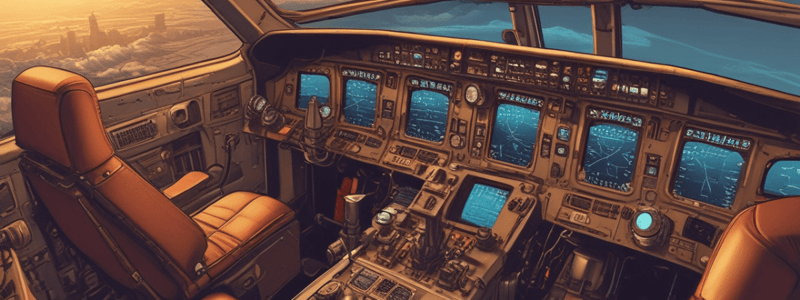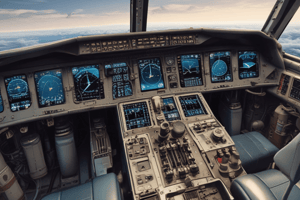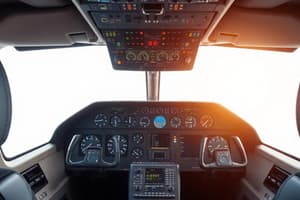Podcast
Questions and Answers
What is asymmetric thrust caused by in a multi-engine aircraft?
What is asymmetric thrust caused by in a multi-engine aircraft?
- Banking of the aircraft during a sideslip
- Use of ailerons during crosswind landings
- Thrust from the remaining engine(s) after an engine failure (correct)
- Failure of the rudder system
What is the primary purpose of using rudder in a sideslip maneuver?
What is the primary purpose of using rudder in a sideslip maneuver?
- To align the aircraft with the runway centerline during crosswind landings
- To increase airspeed during descent
- To maintain the flight path while introducing yaw (correct)
- To counteract drag caused by the inoperative engine
What is the consequence of improper rudder usage during flight?
What is the consequence of improper rudder usage during flight?
- Improved control and reduced structural stress
- Increased airspeed and reduced drag
- Increased drag and loss of control (correct)
- Reduced airspeed and increased drag
During a crosswind landing, what is the primary function of the rudder?
During a crosswind landing, what is the primary function of the rudder?
What is the purpose of banking the aircraft with ailerons during a sideslip?
What is the purpose of banking the aircraft with ailerons during a sideslip?
What is the benefit of mastering the effective use of the rudder?
What is the benefit of mastering the effective use of the rudder?
During an engine failure, what must the pilot use to counteract the yawing moment?
During an engine failure, what must the pilot use to counteract the yawing moment?
What is the result of using rudder to introduce yaw during a sideslip?
What is the result of using rudder to introduce yaw during a sideslip?
What is the primary purpose of the rudder in normal flight operations?
What is the primary purpose of the rudder in normal flight operations?
What is the consequence of not using the rudder to counteract asymmetric thrust?
What is the consequence of not using the rudder to counteract asymmetric thrust?
In a multi-engine aircraft, the yawing moment created by asymmetric thrust can be completely eliminated by the pilot.
In a multi-engine aircraft, the yawing moment created by asymmetric thrust can be completely eliminated by the pilot.
The rudder is only used in emergency situations, such as engine failure.
The rudder is only used in emergency situations, such as engine failure.
A sideslip maneuver can be used to increase airspeed without gaining altitude.
A sideslip maneuver can be used to increase airspeed without gaining altitude.
In a crosswind landing, the ailerons are used to align the aircraft with the runway centerline.
In a crosswind landing, the ailerons are used to align the aircraft with the runway centerline.
Improper use of the rudder can result in increased lift and reduced drag.
Improper use of the rudder can result in increased lift and reduced drag.
The rudder is only used during takeoff and landing.
The rudder is only used during takeoff and landing.
Asymmetric thrust is only a concern in single-engine aircraft.
Asymmetric thrust is only a concern in single-engine aircraft.
Mastering the effective use of the rudder can reduce pilot workload.
Mastering the effective use of the rudder can reduce pilot workload.
In a sideslip, the pilot applies ailerons to introduce bank.
In a sideslip, the pilot applies ailerons to introduce bank.
The rudder is not used in normal flight operations, only in emergency situations.
The rudder is not used in normal flight operations, only in emergency situations.
How does the deflection of the rudder affect the airflow around the vertical stabilizer?
How does the deflection of the rudder affect the airflow around the vertical stabilizer?
What is the primary axis around which the rudder manipulates the aircraft?
What is the primary axis around which the rudder manipulates the aircraft?
What factor influences the rudder's control authority during flight?
What factor influences the rudder's control authority during flight?
What is the term for the alignment of the aircraft's lateral motion with its longitudinal axis during turns?
What is the term for the alignment of the aircraft's lateral motion with its longitudinal axis during turns?
In what phase of flight is the rudder particularly useful due to crosswinds?
In what phase of flight is the rudder particularly useful due to crosswinds?
What is the role of the rudder in engine-out scenarios in multi-engine aircraft?
What is the role of the rudder in engine-out scenarios in multi-engine aircraft?
How does the rudder interact with ailerons during turns to achieve coordinated flight?
How does the rudder interact with ailerons during turns to achieve coordinated flight?
What is the result of the rudder's deflection on the aircraft's tail section?
What is the result of the rudder's deflection on the aircraft's tail section?
What is the purpose of the rudder in normal flight operations, aside from emergency situations?
What is the purpose of the rudder in normal flight operations, aside from emergency situations?
What is the relationship between the rudder's deflection and the direction of the resulting yaw?
What is the relationship between the rudder's deflection and the direction of the resulting yaw?
Flashcards are hidden until you start studying
Study Notes
Aircraft Control Systems
- Aircraft control systems enable pilots to command the skies, with a critical component being the ailerons, which provide lateral control.
Ailerons
- Ailerons are located on the trailing edge of each wing and work in opposition to each other.
- When one aileron is deflected upward, its partner on the opposite wing deflects downward, creating a differential in lift across the wings.
- Ailerons are essential for roll control, allowing pilots to manage the aircraft's roll about its longitudinal axis.
- Ailerons can cause adverse yaw, which occurs due to the added drag on the wing with the down deflected aileron, causing the aircraft's nose to swing into the raising wing.
Coordinated Turns
- Coordinated turns require simultaneous aileron and rudder input to prevent adverse yaw and ensure smooth and pleasant turns.
- Coordinated use of ailerons with other flight controls is crucial for operational safety, as uncoordinated turns can lead to increased stall speed, elevated risk of spin, and sub-optimal performance.
Pitch Control
- Elevators are located on the tail section and control the aircraft's pitch, altering the airflow over the wings and changing the amount of lift.
- Elevators are essential during takeoff and landing, where a higher pitch angle helps lift the plane off the runway and gradually lower the nose for a safe touchdown.
Pitch Trim and Stability
- Trim systems adjust the default position of the elevator, alleviating the need for constant pressure on the control column and allowing the plane to maintain a desired pitch with less effort.
- Proper understanding of elevator use is crucial, as throttle control and power adjustments are equally significant in changing altitude.
Rudder
- The rudder is a critical component located on the vertical stabilizer of the aircraft's tail section, controlling the aircraft's yaw (side-to-side movement of the nose).
- Rudder deflection alters the airflow around the vertical stabilizer, creating an aerodynamic force that pushes the tail in the opposite direction, causing the nose to yaw accordingly.
- Rudder effectiveness is influenced by airspeed, with more airflow over the control surface increasing the control authority.
Rudder Usage
- Rudder is used during takeoff and landing to counteract crosswinds, and in coordination with ailerons during turns to achieve coordinated flight.
- Rudder is vital in engine-out scenarios in multi-engine aircraft to counteract asymmetric thrust and maintain directional control.
- Rudder is used in advanced maneuvers such as sideslips and crosswind landings, and improper use can lead to increased drag, loss of control, or structural stress on the aircraft.
Ailerons
- Ailerons are critical components of an aircraft's lateral control, located on the trailing edge of each wing
- They work in opposition to each other, with one aileron deflecting upward and the other downward
- This design allows pilots to manage the aircraft's roll about its longitudinal axis (from nose to tail)
- Ailerons create a differential in lift across the wings, enabling the aircraft to roll to the right or left
Adverse Yaw
- Aileron-induced roll can cause adverse yaw, a secondary effect that occurs due to the added drag on the wing with the down-deflected aileron
- Adverse yaw causes the aircraft's nose to momentarily swing into the raising wing
- Experienced pilots counteract this with coordinated rudder input to ensure smooth and effective turns
Coordinated Flight
- Coordinated flight occurs when the aircraft's lateral motion is perfectly aligned with its longitudinal axis
- This is achieved by pairing aileron and rudder input simultaneously, resulting in a smooth and efficient turn
- Uncoordinated turns can lead to increased stall speed, elevated risk of spin, and sub-optimal performance
Elevator
- The elevator is a movable control surface located on the tail section of most fixed-wing aircraft
- It is attached to the horizontal stabilizer and can move up and down
- The primary function of the elevator is to control the pitch of the aircraft, which is the angle of the nose relative to the horizon
Pitch Control
- Pitch directly affects the lift generated by the wings
- By adjusting the pitch, pilots can climb, descend, or maintain level flight
- The elevator's movement is crucial for maintaining equilibrium during various phases of flight
Rudder
- The rudder is a critical component located on the vertical stabilizer of the aircraft's tail section
- It plays a fundamental role in controlling the aircraft's yaw, which is the side-to-side movement of the nose of the airplane
- The rudder is used to manipulate the aircraft along its vertical axis
Rudder Control
- The rudder's effectiveness is influenced by several factors, including airspeed, as more airflow over the control surface increases the control authority
- It is used differentially with ailerons during turns to achieve coordinated flight
- The rudder is vital during engine-out scenarios in multi-engine aircraft, where it helps to counteract asymmetric thrust and maintain directional control
Ailerons
- Ailerons are located on the trailing edge of each wing and work in opposition to each other.
- When one aileron is deflected upward, its partner on the opposite wing deflects downward.
- Ailerons are essential to roll control, allowing pilots to manage the aircraft's roll about its longitudinal axis.
- When the right aileron moves up, the left aileron moves down, creating a differential in lift across the wings, and the aircraft rolls to the right.
- Aileron-induced roll can cause adverse yaw, which is a secondary effect that occurs due to the added drag on the wing with the down-deflected aileron.
- To counteract adverse yaw, pilots need to apply coordinated rudder input to ensure smooth and effective turns.
Importance of Ailerons
- Coordinated use of ailerons with other flight controls is crucial for operational safety.
- Uncoordinated turns can lead to increased stall speed, an elevated risk of spin, and sub-optimal performance.
- Pilots must remain vigilant and use trim to reduce control forces and ensure the ailerons are not held in an inefficient or hazardous position.
- Common pilot errors associated with improper aileron use include overbanking during initial training or inattentiveness to coordinated flight.
Elevators
- Elevators are movable control surfaces located on the tail section of most fixed-wing aircraft.
- The primary function of the elevator is to control the pitch of the aircraft, which is the angle of the nose relative to the horizon.
- By adjusting the pitch, pilots can climb, descend, or maintain level flight.
- Elevator movement causes the tail to rise or lower, and the nose to pitch up or down, which affects the lift generated by the wings.
Importance of Elevators
- Controlling pitch is important for maintaining equilibrium during various phases of flight, such as ascent, descent, cruising, and maneuvering.
- Elevators play a crucial role in takeoff and landing, where a higher pitch angle helps to lift the plane off the runway and a lower pitch angle helps to bring the aircraft to a safe touchdown.
- Pitch trim and stability are essential for reducing pilot workload and allowing the plane to maintain a desired pitch with less effort.
Rudders
- Rudders are critical components located on the vertical stabilizer of the aircraft's tail section.
- Rudders play a fundamental role in controlling the aircraft's yaw, which is the side-to-side movement of the nose of the airplane.
- Rudder deflection alters the airflow around the vertical stabilizer, creating an aerodynamic force that pushes the tail to the left or right, causing the nose to yaw accordingly.
- Rudder effectiveness is influenced by factors such as airspeed, as more airflow over the control surface increases the control authority.
Importance of Rudders
- Rudders are particularly useful in various phases of flight, such as during takeoff and landing when crosswinds may affect the aircraft's trajectory.
- Rudders are used differentially with ailerons during turns to achieve coordinated flight and prevent side-slips and inefficient aerodynamics.
- Rudders are vital during engine-out scenarios in multi-engine aircraft.
Studying That Suits You
Use AI to generate personalized quizzes and flashcards to suit your learning preferences.




